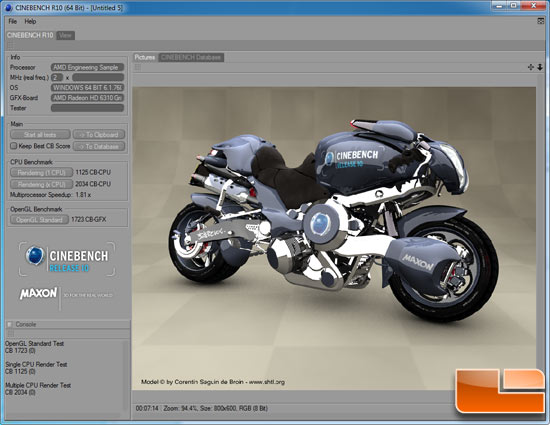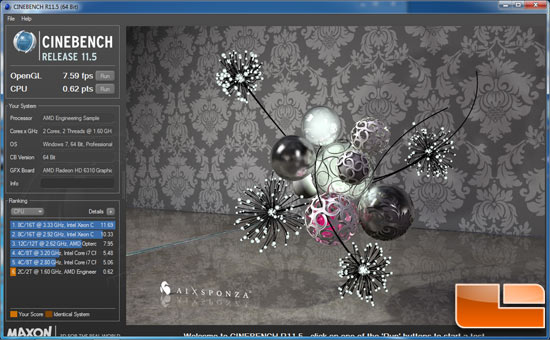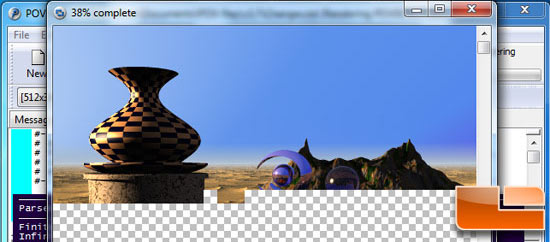AMD Brazos Platform Benchmarked – Zacate E-350 1.6GHz APU
Cinebench & Pov-Ray
Cinebench R10
CINEBENCH is the free benchmarking tool for Windows and Mac OS based
on the powerful 3D software CINEMA 4D. Consequently, the results of
tests conducted using CINEBENCH 10 carry significant weight when
analyzing a computer’s performance in everyday use. Especially a
system’s CPU and the OpenGL capabilities of its graphics card are put
through their paces (even multiprocessor systems with up to 16
dedicated CPUs or processor cores). The test procedure consists of two
main components: the first test sequence is dedicated to the computer’s
main processor. A 3D scene file is used to render a photo realistic
image. The scene makes use of various CPU-intensive features such as
reflection, ambient occlusion, area lights and procedural shaders. In
the first run, the benchmark only uses one CPU (or CPU core) to
ascertain a reference value. On machines that have multiple CPUs or CPU
cores, and also on those who simulate multiple CPUs (via HyperThreading
or similar technologies), MAXON CINEBENCH will run a second test using
all available CPU power. Again, higher Frames/Second and lower
rendering time in seconds equal better performance.

Cinebench R10 was able to put a 100% load across all the cores on
all of the processors, which makes this a great benchmark to look at
multi-core platforms. The test results here shows a single CPU render test score of 1125 and 2034 on the multi-CPU benchmark. This is a multiprocessor speedup of 1.81x. The OpenGL Benchmark score was 1723 for those that like this benchmark for the OpenGL standard test.
Cinebench R11.5
MAXON recently released CINEBENCH Release 11.5, an advanced hardware
testing suite that assesses a computer’s performance capabilities.
CINEBENCH is based on the same powerful technology as MAXON’s
award-winning animation software CINEMA 4D, which is used extensively by
studios and production houses worldwide for 3D content creation. The
new version of CINEBENCH includes the ability to more accurately test
the industrys latest hardware, including systems with up to 64
processor threads, and the testing environment better reflects the
expectations of todays production demands. A more streamlined interface
makes testing systems and reading results incredibly straight forward.
Again, higher Frames/Second and point score equal better performance.

POV-Ray 3.7 Beta 34
Processor Performance on Pov-Ray 3.7 Beta 34:
The Persistence of Vision Ray-Tracer was developed from DKBTrace 2.12
(written by David K. Buck and Aaron A. Collins) by a bunch of people
(called the POV-Team) in their spare time. It is a high-quality, totally
free tool for creating stunning three-dimensional graphics. It is
available in official versions for Windows, Mac OS/Mac OS X and i86
Linux. The POV-Ray package includes detailed instructions on using the
ray-tracer and creating scenes. Many stunning scenes are included with
POV-Ray so you can start creating images immediately when you get the
package. These scenes can be modified so you do not have to start from
scratch. In addition to the pre-defined scenes, a large library of
pre-defined shapes and materials is provided. You can include these
shapes and materials in your own scenes by just including the library
file name at the top of your scene file, and by using the shape or
material name in your scene. Since this is free software feel free to download this version and try it out on your own.
The most significant change from the end-user point of view between
versions 3.6 and 3.7 is the addition of SMP (symmetric multiprocessing)
support, which, in a nutshell, allows the renderer to run on as many
CPU’s as you have installed on your computer. This will be particularly
useful for those users who intend on purchasing a dual-core CPU or who
already have a two (or more) processor machine. On a two-CPU system the
rendering speed in some scenes almost doubles. For our benchmarking we
used version 3.7 beta 34, which is the most recent version
available. The benchmark used all available cores to complete the
render.

Once rendering on the object we selected was completed, we took the
score from dialog box, which indicates the average PPS for the
benchmark. A higher PPS indicates faster system performance. Our AMD Zacate E-350 completed the benchmark in 7 minutes and 39 seconds with a score of 574.17 PPS in the multi-threaded benchmark.

Comments are closed.